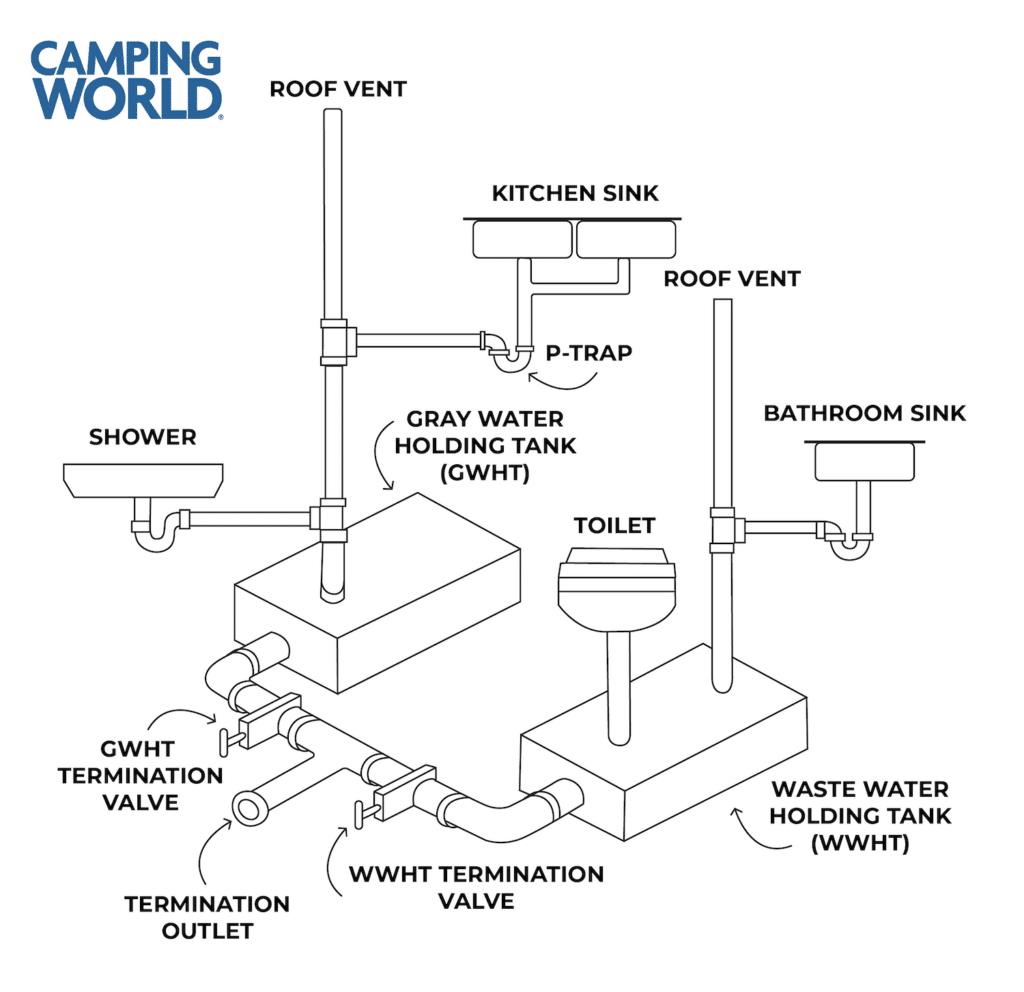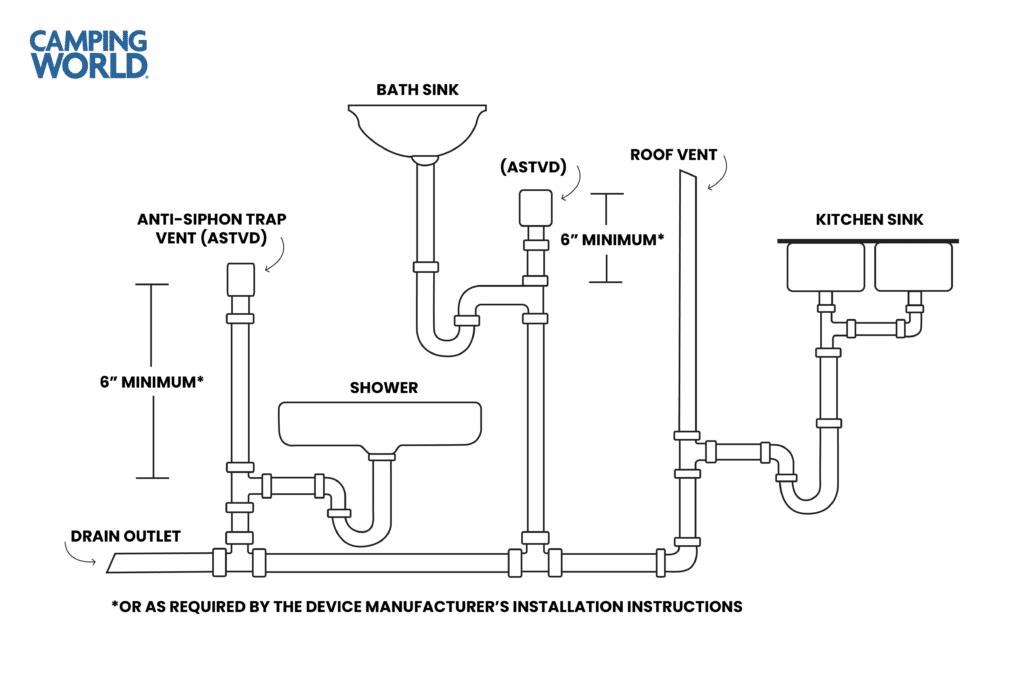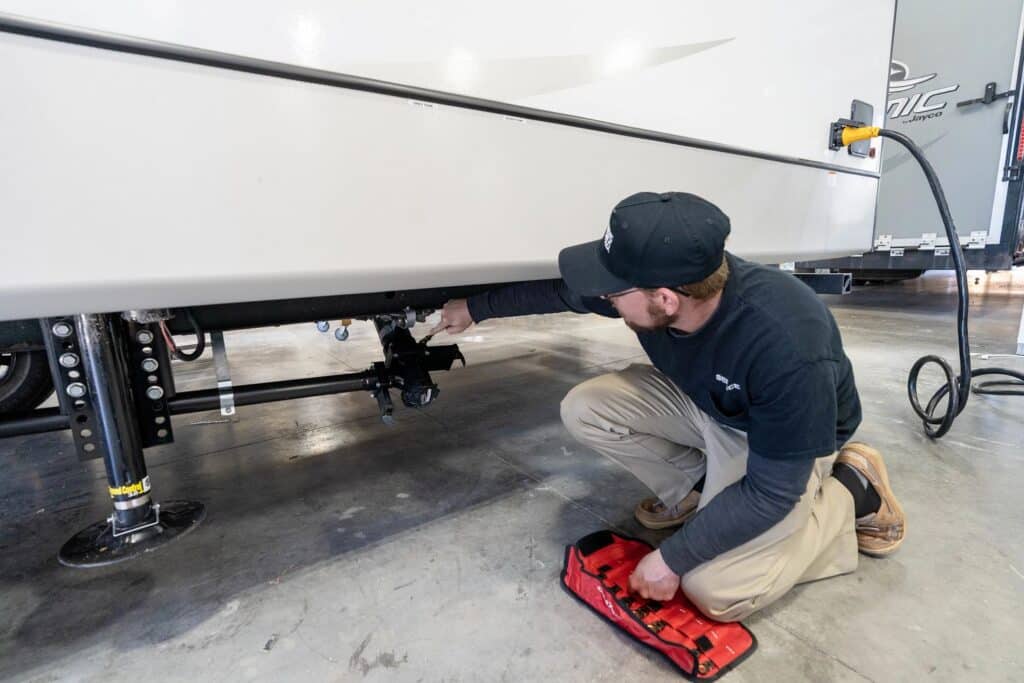Every RVer can benefit from understanding how their electrical systems, security systems, and, in this case, RV plumbing systems are designed. It’ll help you use them properly, maintain them carefully, and troubleshoot issues when they arise.
In this article, we’re focusing on how RV plumbing systems work. More specifically, we’ll focus on the plumbing that’s responsible for the disposal of wastewater. For an overview of the plumbing used to deliver fresh water, read our full overview of RV water systems.
How Does RV Plumbing Work?
RV plumbing – drainage systems – ensure that your wastewater is safely transferred to your RV’s holding tanks. They also guarantee the safe draining of those tanks from your system’s outlet into a dump station or sewer drain at an RV site.
RV water systems must be built with drainage capability for wastewater according to the specifications outlined in NFPA 1192 and CSA Z240. The image below depicts an example of an RV plumbing system:

Most larger motorhomes and travel trailers are equipped with this drainage system. In it, notice that the single termination outlet empties both holding tanks (gray and black). If you’re unfamiliar with the process, consult our tutorial to learn how to empty your RV’s holding tanks.
Some pop-up campers and truck campers employ a flexible drainage system. This system doesn’t feature holding tanks, requiring users to empty the tank into a portable RV waste tank. Generally, you’ll only find this system on RVs with a single compartment sink or shower.
Components of RV Plumbing Systems

Photo by Camping World
RV plumbing systems are made up of several components:
Fixture Tailpieces (Continuous Wastes)
A fixture tailpiece is a short piece of piping situated between a fixture’s drain and its trap. They are typically built with ABS plastic or PEX tubing.
P-Traps
P-traps are the most common type of plumbing trap used in RVs. They are installed at every fixture in your RV’s plumbing system to prevent gases and odors from entering the RV through the drainage lines.
These odors come from your RV’s holding tanks or the sewer system to which you’re connected. These traps eliminate odors by creating a barrier of water that prevents gases from moving upstream from those sources.
Piping and Fittings
ABS plastic is the material that’s most commonly used for RV plumbing piping and fittings. The piping utilized to drain your gray waste tank can be as small as 1.5 inches in diameter but can be up to three inches in diameter. The piping used to drain your RV’s black water holding tank must be at least three inches in diameter.
Vents
RV construction specifications require venting at every fixture and each holding tank in an RV’s plumbing system. Venting is crucial to odor control and ensures proper draining of sinks and holding tanks by maintaining adequate airflow in and out of the system.
Some RVs employ a device known as an anti-siphon trap vent device (ASTVD). Sometimes called a check vent, this device is installed downstream of a trap to vent the system. However, it only functions as a secondary vent and must be combined with a primary roof vent.

Termination Fittings and Valves
RV plumbing systems are drained through a termination outlet or fitting that’s located on the RV’s exterior. According to RV standards, this outlet must be on the left (driver’s side) of your RV and be positioned within 22.5 feet of the rear (or along the rear on truck campers).
The outlet consists of a drain connecting fitting and hand-operated termination valves or full-way valves. These valves should only be opened once your sewer hose is connected to the drain outlet, with the downstream end secured into a drain inlet for an in-ground sewer system.
Holding Tanks
Most RVs are equipped with at least two holding tanks: a gray water tank and a black water tank. The gray water tank collects the liquid waste draining from the shower and sinks, while the black water tank collects body waste from your RV toilet.
You may find larger RVs with multiple gray water tanks, and you’ll also find smaller units without a black water tank if they don’t have an RV toilet inside. For the latter, a portable camping toilet is your best solution.
FAQs About RV Plumbing

Photo by Camping World
Now that you understand the basics of RV plumbing, here are some of the most commonly asked questions about this aspect of your recreational vehicle:
What Size is RV Plumbing?
The plumbing lines for your RV’s black water tank outlet must be at least three inches in diameter. The outlet for your gray water tank can be anywhere from 1.5-3 inches in diameter. The most common sizes for RV freshwater lines are ½” and ⅜” PEX tubing.
Can You Use Liquid Plumber in an RV?
We DON’T recommend using chemical cleaners like Liquid Plumber or Drano in your RV. Your RV’s plumbing system features rubber seals that can be damaged and compromised by a chemical cleaner, resulting in leaks.
To maintain your RV’s plumbing systems, you’ll need sewer chemicals specifically designed for RV use. Explore our selection of RV sewer chemicals.
Is Plumbing Antifreeze the Same as RV Antifreeze?
No, RV antifreeze and standard antifreeze used for other plumbing and automotive applications are completely different products. Like sewer chemicals, RV antifreeze is non-toxic and designed specifically for safe use with your RV’s plumbing.
Learn more about RV antifreeze and when/how to use it in your recreational vehicle.
Septic issues are the last thing you think about when you buy a new RV. So here are a few more resources to help you use your RV’s plumbing system correctly and avoid smelly, messy issues:
- Is it Really Necessary to Use RV Toilet Paper?
- How to Maintain RV Holding Tanks
- How to Unclog Your RV Black Tank
View our full collection of tutorials on RV waste and plumbing.
Do you have any questions about RV plumbing systems? Let us know in the comments below.
The post How Does RV Plumbing Work? appeared first on Camping World Blog.
By: Tucker Ballister
Title: How Does RV Plumbing Work?
Sourced From: blog.campingworld.com/learn-to-rv/how-does-rv-plumbing-work/
Published Date: Wed, 06 Sep 2023 08:00:00 +0000
---------------------------------------------
 CampingSurvivalistHuntingFishingExploringHikingPrivacy PolicyTerms And Conditions
CampingSurvivalistHuntingFishingExploringHikingPrivacy PolicyTerms And Conditions
